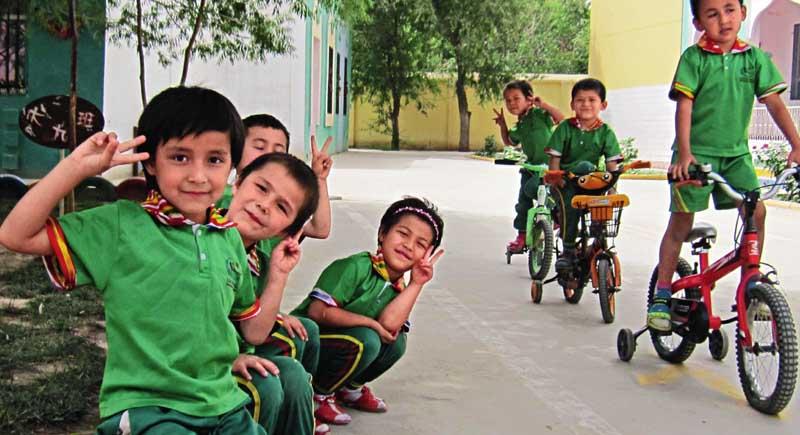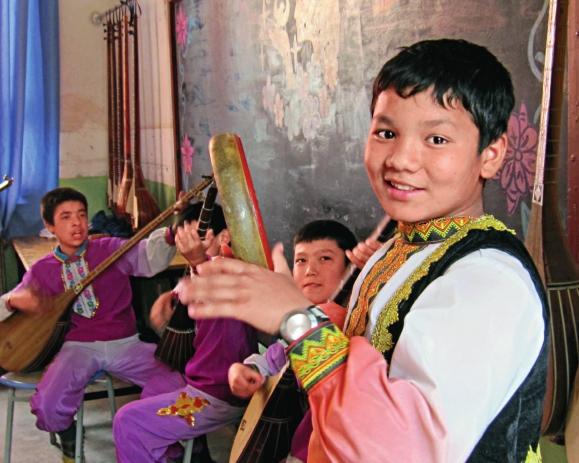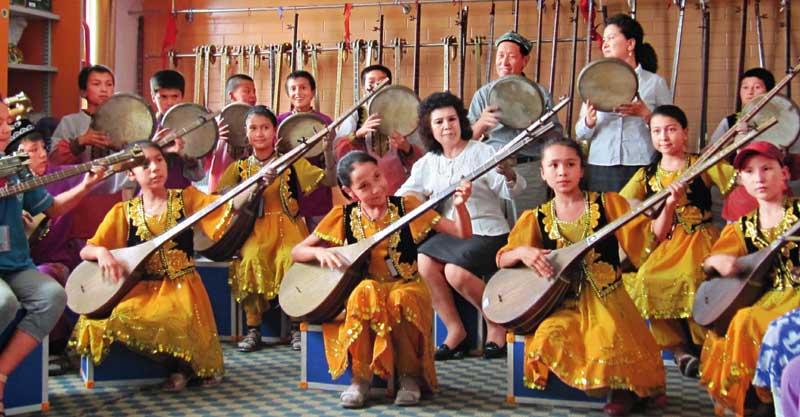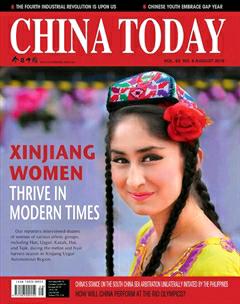Xinjiang’s Free Bilingual Education
By staff reporter JIAO FENG
NO fees for tuition and textbooks, free accommodation for students from poverty-stricken areas – all expenses are covered by government fiscal expenditure. These preferential policies had covered all places of Xinjiang Uygur Autonomous Region by the end of 2015, thus ushering in an era of free compulsory education in Xinjiang.
In June our reporters visited the Central Kindergarten and Central Primary School in Xiamalebage Township of Kashgar City to see how local kids have benefited from the free compulsory education. At present, both the kindergarten and the primary school enrollment rates have reached 100 percent. Aside from bilingual education, kindergarten accommodation and pupils extracurricular activities are all free. Children there can acquire knowledge and learn football, painting, dancing and musical instruments. These colorful extracurricular activities not only cultivate their hobbies and open up new vistas, but also help them to achieve more in the future.
Study and Play
“Duck mother, have you seen our mother? Please tell us what she looks like?”
“Yes. Your mother has two big eyes and one big mouth. Go find her yourself.”
Entering a classroom in the Central Kindergarten, we saw kids wearing different animal costumes perform a drama titled Little Tadpoles Looking for Mummy. Their mellifluous voices and sweet and innocent expressions immediately riveted our attention. According to kindergarten principal Rayhangul Abdukerim, in order to develop childrens Chinese listening and speaking ability, they often arrange childrens skits to afford them an environment in which to practice Chinese dialogues and thereby arouse their interest in the language.
In another multimedia classroom, a teacher held up a “talking” pen while playing games with her pupils. She pointed to a question mark on the wall with the pen, and the pen “voice” asked the question, telling kids to identify the thing. According to Rayhangul, the multimedia classroom was purposebuilt not only to help kids pronounce standard Chinese, but also to correct their teachers pronunciation. The talking pen helps children to learn the language quickly by hearing it correctly spoken.
In a classroom for life experience, a teacher showed kids how to make dumplings, while in another classroom children conducted scientific experiments under their teachers guidance. In the playground outside a few students were learning traffic rules. One kid played the part of a traffic warden, earnestly exhorting others to cross the road at the intersection according to the traffic light.
The kindergarten has 635 kids of various ethnicities in 17 classes. These children mainly come from nearby towns, including those from the floating population. Rayhangul informed us that the kindergarten applies Uygur-Chinese bilingual education, and sets quality-oriented education at the core with play activities as the primary format. It thus helps children learn knowledge and bring their creativity into full play in the course of playing games, so promoting their all-around development. The kindergarten also organizes activities, such as a footballfan class, parent-child games, drawing contests and artistic performances. They enhance pupils communicative capability, while steering them towards self-expression through various creative media, as well as incrementally inculcating sound behavioral habits as an incident to this production process.
“Xinjiang now enforces two-year free education for pre-school children aged five and above. Our kindergartens enrollment rate tops 100 percent, as a number of the unregistered floating population also send their children here,” said the principal.“This not only provides a kid with better study and living conditions, but also frees a housewife to work, thus increasing the family income.”
Rural Childrens Palace
Erected in 1934, the Central Primary School is a time-honored comprehensive elementary school in its locale. The school has 1,793 students in 41 classes, with a bilingual education rate of 100 percent. According to headmaster Abduheni Abliz, in 2015 the schools football team won the national championship in the ‘Who is the King? childrens league, a nationwide ethnic football championship series. “This league totally benefits from our plan for a ‘Rural Childrens Palace,” he said proudly.
Instituted in 2011, the Rural Childrens Palace is a public welfare program for rural students. Based on existing sites, classrooms and facilities in the Central Primary School, a number of extra curricular activities are freely open to students during their spare time and on holidays. Abduheni said that, in 2011, the school received a 200,000-yuan initial fund to purchase a variety of facilities. In the following years the school has received a yearly grant of RMB 70,000 for activities. The school today boasts 21 clubs, covering football, dancing, drawing, handicrafts and musical instruments, which organize activities twice a week. Students can enroll in the clubs based on their interests.

This semester, 11-year-old Eliyarjan Xamxidin registered with two clubs – football and drawing. According to his mother, Mehrigul Mijit, the introverted boy did not like to communicate with others, but since joining the clubs, he has become more outgoing and his school marks have improved as well. “The more he learns, the better comprehensive development and comprehension he will gain,”his mother said.
Sawirdin Rozikari is a pretty Uygur girl with a fair complexion, curly hair and refined doll-like features. She has played the violin for one and a half years. “I only saw the violin on TV and in books before, but never got the chance to see the real thing,”Sawirdin said. When the violin club formed, she was attracted by the wonderful tones she heard and enlisted as a member. “My dream is to become a violinist,” she said. She can now play several etudes.
Better Understanding of the World
In the past five years Xinjiang has made unprecedented investment in education, averaging expenditures of more than RMB 50 billion per year. The proportion of fiscal education expenditure to GDP has been higher than the national standard (four percent) for years. A number of reconstruction projects have also been implemented in rural primary and secondary schools. Xinjiang also took the lead in establishing a long-term fund guarantee system for preschool bilingual education. Since 2014, all Southern Xinjiang has been covered by free senior high school education. As for compulsory education in rural areas, subsistence allowances for boarding students from needy families have doubled. The nutrition improvement plan provides almost one million students with free lunches. The subsidy system has moreover been established and fortified, and now encompasses stages from preschool to higher education.
At present, Xinjiang has 3,239 kindergartens, which now enroll 520,000 kids from minority ethnic groups. The popularization rate of preschool bilingual education has increased to 90 percent, while the net enrollment rate of school-age children is 99.85 percent. More than two million students have thus far received bilingual education. Headmaster Abduheni relates how, in addition to lessons in the Chinese and Uygur languages, classes like math, science and IT are taught in Chinese, while other classes like music and physical education are taught in Uygur.
As a parent, Mehrigul wholeheartedly endorses her childs receipt of bilingual education. “When I went to primary school, there was no class that taught Chinese. I didnt learn Chinese until I was a junior high school student. Knowing Chinese became an advantage for me when looking for a job,”she said. “As the national language, the whole nation should understand Chinese. Besides, far more books and information are available in Chinese than in Uygur. To gain more knowledge, it is necessary to learn the Chinese language.”
In order to further popularize bilingual education, Xinjiang will gradually invest more in the special fund during the 13th Five-Year Plan period(2016-2020), focusing on southern Xinjiang and rural areas, thus ensuring balanced educational development. Furthermore, Xinjiang will strive to solve the problem of a shortage of bilingual teachers in southern Xinjiang and matriculate 2,200 free students at normal colleges each year.

